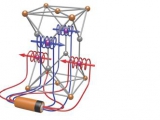The unique L3-HAPLS laser system, developed by the Lawrence Livermore National Laboratory (LLNL) for ELI Beamlines, was on July 2, 2018, ceremonially launched. After evaluation by an international peer review group, it has been declared fully integrated and operational. The system is ready for integration with the experimental systems and...














